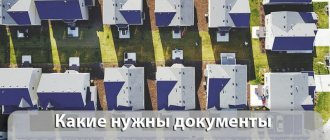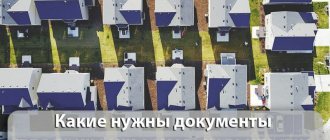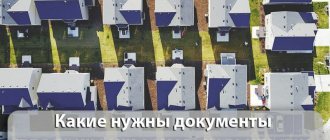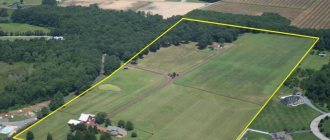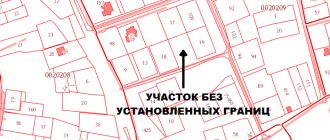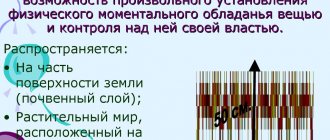How to register the addition of a land plot in accordance with the Land Code
The Land Code does not contain such a concept - the addition of a land plot. Redistribution of land plots is commonly called redistribution. According to the general rules for the formation of land plots (Article 11.2 of the Land Code), there are several types of formation of new land plots:
- Allocation;
- An association;
- Redistribution;
- Chapter.
In the article we will not consider each of these types in detail, but we will talk in more detail about redistribution, or more precisely about how the addition of a land plot in 2021 occurs due to the area of adjacent lands, and how the size of a land plot can be legally increased.
When can and cannot be performed?
You can legalize ownership of a plot of land for free:
- if a house was built on it and it was received free of charge (by disabled people, large families, etc.);
- is in lifelong inheritable ownership;
- has actually been in use for at least 15 years;
- has an agricultural purpose, for subsidiary farming (more details about the privatization of agricultural land are written here);
- is part of a non-profit association.
There are a number of lands that do not fall under the rules of free privatization (clauses 4, 5 of Article 27 of the Land Code of the Russian Federation):
- reserves withdrawn from civil circulation, for example;
- limited from circulation: intended for municipal and state use, forest areas, etc.
About which categories of land are not subject to either free or paid privatization is written in a separate publication.
New law on land acquisition 2021
Laws in the field of land management and cadastre have undergone active changes in recent years. The new law on the addition of land plots, effective in 2021, is a whole layer of rules affecting the formation of land plots. At the beginning of 2019, Federal Law 217 on horticulture came into force, changing the basic concepts and definitions of summer cottages. On June 17, 2021, a new law 150-FZ was adopted, amending the laws on cadastral activities and real estate registration (218-FZ and 221-FZ). The changes concern complex cadastral works: the procedure for carrying them out is simplified, while it remains possible to increase the land plot up to 10% of its total area if, during the complex cadastral works, it turns out that in fact the plot is larger than on paper. The State Duma is also considering a number of amendments to simplify the procedure for registering land plots and buildings (the dacha amnesty will be extended until 2022).
Only the owner can add additional acres to his plot. Tenants of land plots, as well as persons who own land plots for free use, do not have this opportunity.
Mandatory purchase of property under clause 7 of Article 107 of the Land Code of the Russian Federation: does the novelty work?
In August 2021, amendments to the Land Code came into force regarding the regulation of zones with special conditions for the use of territories (ZOUIT) (these include various kinds of security, prohibited zones, etc., which impose certain restrictions on the territory).
Among the short stories, the provisions of paragraph 7 of Art. 107 of the Land Code of the Russian Federation - now a person, if the ZOOIT regime has been extended to his plot, has the right to demand from the government agency in whose interests it was established to buy it (and the real estate on it). At the same time, this provision also received retrospective effect.
This approach seems logical - the restrictions may turn out to be so significant that it is simply impossible to use the land plot for the purposes for which it was originally acquired (for example, for construction). Accordingly, so that the owner does not continue to bear the burden of maintaining property that he now does not need and which will now not be so easy to sell to third parties, the state has provided a mechanism for the alienation of a plot with the payment of compensation.
However, it must be noted that in practice some problems arose with the implementation of the mechanism.
Thus, the cited Article 107 of the Land Code of the Russian Federation states that the procedure for concluding a buyout agreement and paying compensation is established by the Decree of the Government of the Russian Federation.
And although these rules came into force in August 2021, as of December 26, 2021, this Resolution has still not been adopted.
This situation was used to avoid fulfilling the obligation to redeem the property.
For example, in a case considered by the Moscow City Court (No. 33a-3675/2019), the plaintiff asked to oblige the government agency to buy the plot from him on the basis of clause 7 of Article 107 of the Land Code of the Russian Federation. However, the court refused, motivating its decision by the fact that due to the lack of a redemption procedure that would be established by the aforementioned Government Resolution, the government agency does not have the opportunity to fulfill this obligation.
This approach of the court, as well as the current situation as a whole, raises questions.
In particular, does a person for whom it is obligatory by law to conclude an agreement (Article 445 of the Civil Code of the Russian Federation) have the right to evade it due to the lack of a procedure that would regulate his behavior when concluding this agreement?
Also, what is the reason for such a significant delay in establishing this procedure? It turns out that the state, fulfilling its public functions, first grants citizens and organizations a certain right, then creates conditions that interfere with its implementation?
Also, it must be taken into account that the burden of maintaining property that has ended up in the ZOUIT can be very heavy. Persons who were granted the right to receive compensation for restrictions established in the public interest have been paying taxes and incurring other expenses instead of this compensation for more than a year now.
Perhaps it would be fair to assign these costs to the state, since they arose due to its failure to adopt an act necessary, again, for public education?
However, there is no need to count on this.
We can only hope that, since judicial practice under Article 107 of the RF Land Code is still being formed and only a single such example is given above, in the future it will develop in a slightly different way, and the Government of the Russian Federation will finally issue the discussed Resolution in the near future.
Sanctions for illegal land seizure
Cases of illegal seizure of land are established by Art. 7.1 Code of Administrative Offences. If fraudulent aspects are identified, the case may fall under the criminal code. With this option, the offense faces much more serious consequences than just a fine and seizure of the site. In the absence of fraudulent activity, the violator will most likely pay a fine. Its size depends on several factors:
- whether the plot is registered in the cadastral register;
- What is the estimated value of this plot of land?
How to legalize the addition of a plot of land for free
Attaching a land plot to the main one is an increase in the size of the land plot at the expense of adjacent lands. Not every owner is aware that he can legally register an addition to a land plot and receive additional land ownership free of charge. How to legalize the cutting of a plot of land for free, you ask? In fact, the law allows the increase of a land plot by no more than 10% of its area at the expense of municipal lands. But there are also caveats. It is important that the land is not privately owned and under encumbrances; in addition, local authorities have the right to legally establish additional restrictions on the size of the addition of land plots. In any case, the registration of the addition of a land plot should be legalized by submitting the necessary documents to the Rosreestr authorities.
What to do if the property is owned, but the land is not?
The transfer of property rights from the state or municipality to the owner of real estate, in this case of a land plot, is called privatization.
According to the Land Code of the Russian Federation, registration of ownership of a house does not mean that the land on which it is located also becomes full possession. The plot is in perpetual use by the owner of the house. If desired, he can engage in privatization.
What documents are needed to approximate a plot of land?
The desire to increase the land plot is not enough; action must be taken. To begin with, find out from the local authorities the nuances of restrictions on the size of the addition of a plot of land in your area, and what documents are needed for the addition of a plot of land in your municipality.
The main documents are:
- Application for cutting (redistribution)
- Agreement
- Extract from the Unified State Register of Real Estate
- Land surveying project or site layout diagram
- Title documents for land.
Time limits for consideration of an application for subdivision of a land plot
The Land Code (Article 39.29) establishes the following deadlines for consideration of an application for the addition of a land plot:
- total period 30 working days
- extension of the period to 45 working days (if additional documents are needed)
- The deadline for returning an incomplete set of documents is 10 days .
After the application is accepted, an agreement is concluded that the municipality is not against increasing your land.
Increasing the area of land - is it free or for money?
There is an opinion that increasing the land plot can be done completely free of charge, but this is not so. It is only possible to obtain the adjacent lands for free, that is, they do not need to be purchased from the state, and the very registration of the new formation in the form of an enlarged land plot after the addition is a procedure that requires monetary costs. Indeed, in order to document newly created possessions, it is necessary to prepare a boundary plan. To do this, we enter into an agreement with a cadastral engineer, naturally on a paid basis. The newly created site must be coordinated and a ready package of documents must be submitted for registration to the MFC. All this time and money, but as a result you will receive a legally registered plot with an increased area.
You can find out the cost of cadastral works using a free service on the website - an online cadastral work calculator.
You can also find a catalog of companies in your region that provide cadastre services on the website.
How to do it?
Let's figure out how to privatize the plot of land under your home?
To begin privatization of a land plot, you must contact the municipality or a branch of the Federal Property Management Agency, depending on whose ownership the land is. To find out who is the owner of the territory, you need to order an extract from the Unified State Register on the website of the state registration service.
This can be done by indicating the address of the location of the site, or its cadastral number. The user and the administration sign an agreement between themselves on the transfer of land into personal ownership. Once the privatization permit is in hand, you need to contact Rosreestr to register the right. An application is written, and the following documents are attached to it:
- Passport.
- Power of attorney if the privatization is handled by an intermediary.
- Original and duplicate receipt for payment of state duty. The size of the payment depends on how the land will be used in the future (how much does it cost to privatize a land plot?).
- Documents confirming the rights to land, for example, an open-ended contract, a lease agreement, etc. (how to privatize leased land?).
- Documents confirming that the house on the site is owned (we talked about how to privatize the land along with the house if it is not owned here).
- Extract from the cadastral plan.
- Notarized consent to the transaction.
- Documents with information on the standard value of the plot received from the Land Committee.
- A document with data on the estimated value of land from the BTI.
- Help with information about land taxes.
- A certificate from the Unified State Register indicating all persons who have rights to the land plot that the applicant wishes to privatize.
Difficulty may arise with the preparation of a cadastral map for the site. If it is not registered, then you must contact the district administration with a request to register it in the real estate cadastre.
To this end, the institution’s specialists will carry out work aimed at clarifying the physical characteristics of the site. Payment for such actions falls on the shoulders of the person involved in land privatization. As a result of all the steps described above, Rosreestr issues the owner an act of transfer of the plot, as well as its diagram.
More information about the procedure and methods for privatizing a land plot can be found here.
If you have privatized a house, you can also register ownership of the land on which it is located. This will give you the opportunity to dispose of your property in full within the framework of the law, and will also protect you from investors who may be attracted to your site.
Instead of a conclusion, or Putin’s opinion on the addition of a plot of land
Vladimir Putin allowed Russians to register surplus land. This benefits both the state and the ordinary citizen. By signing 150-FZ dated June 17, 2019 (the law came into force on September 16, 2019), the president thereby expressed his opinion on the appropriation of land plots and confirmed the need to simplify cadastral work, which, according to the deputy head of the cadastral chamber, Marina Semenova, will have a positive impact on land owners. The registered plots will now officially be the property of citizens - which will increase revenues to the treasury through land taxes, and citizens, in turn, will be able to own plots not only in kind, but also legally.
